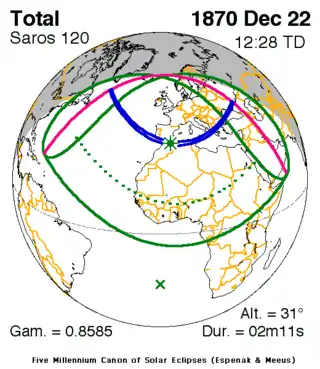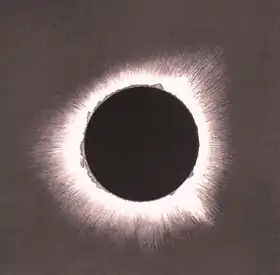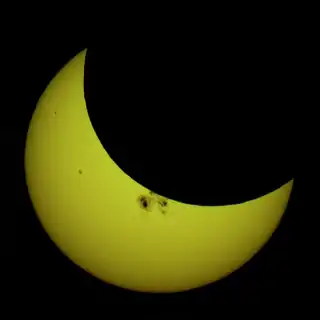Solar eclipse of December 22, 1870
A total solar eclipse occurred on December 22, 1870. A solar eclipse occurs when the Moon passes between Earth and the Sun, thereby totally or partly obscuring the image of the Sun for a viewer on Earth. A total solar eclipse occurs when the Moon's apparent diameter is larger than the Sun's, blocking all direct sunlight, turning day into darkness. Totality occurs in a narrow path across Earth's surface, with the partial solar eclipse visible over a surrounding region thousands of kilometres wide. Totality was visible from southern Portugal and Spain, across northern Algeria, then crossing Sicily, Greece, Bulgaria, and ending in the south-west of the Russian Empire.
| Solar eclipse of December 22, 1870 | |
|---|---|
 Map | |
| Type of eclipse | |
| Nature | Total |
| Gamma | 0.8585 |
| Magnitude | 1.0248 |
| Maximum eclipse | |
| Duration | 131 sec (2 m 11 s) |
| Coordinates | 35.7°N 1.5°W |
| Max. width of band | 165 km (103 mi) |
| Times (UTC) | |
| Greatest eclipse | 12:27:33 |
| References | |
| Saros | 120 (53 of 71) |
| Catalog # (SE5000) | 9213 |
Related eclipses
It is a part of solar Saros 120.
References
- NASA chart graphics
- Googlemap
- NASA Besselian elements
- Mabel Loomis Todd (1900). Total Eclipses of the Sun. Little, Brown.
- Reports on observations of the total solar eclipse of December 22, 1870 By United States Naval Observatory, Simon Newcomb, Asaph Hall, William Harkness, John Robie Eastman
- Solar Eclipse seen from Jerez in 1870
- The sun was crowned in Jerez
| Wikimedia Commons has media related to Solar eclipse of 1870 December 22. |
This article is issued from Wikipedia. The text is licensed under Creative Commons - Attribution - Sharealike. Additional terms may apply for the media files.


.jpg.webp)

